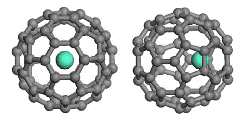Department of Chemistry
Document Type
Article
Date of this Version
2014
Citation
http://dx.doi.org/10.1063/1.4879551
Abstract
Photoelectron spectroscopy and ab initio calculations are used to investigate the structures and chemical bonding of the B25 − cluster. Global minimum searches reveal a dense potential energy landscape with 13 quasi-planar structures within 10 kcal/mol at the CCSD(T)/6-311+G(d) level of theory. Three quasi-planar isomers (I, II, and III) are lowest in energy and nearly degenerate at the CCSD(T) level of theory, with II and III being 0.8 and 0.9 kcal/mol higher, respectively, whereas at two density functional levels of theory isomer III is the lowest in energy (8.4 kcal/mol more stable than I at PBE0/6-311+G(2df) level). Comparison with experimental photoelectron spectroscopic data shows isomer II to be the major contributor while isomers I and III cannot be ruled out as minor contributors to the observed spectrum. Theoretical analyses reveal similar chemical bonding in I and II, both involving peripheral 2c-2e B−B σ-bonding and delocalized interior σ- and π-bonding. Isomer III has an interesting elongated ribbon-like structure with a π-bonding pattern analogous to those of dibenzopentalene. The high density of low-lying isomers indicates the complexity of the medium-sized boron clusters; the method dependency of predicting relative energies of the low-lying structures for B25 − suggests the importance of comparison with experiment in determining the global minima of boron clusters at this size range. The appearance of many low-lying quasi-planar structures containing a hexagonal hole in B25 − suggests the importance of this structural feature in maintaining planarity of larger boron clusters.



Comments
Used by permission